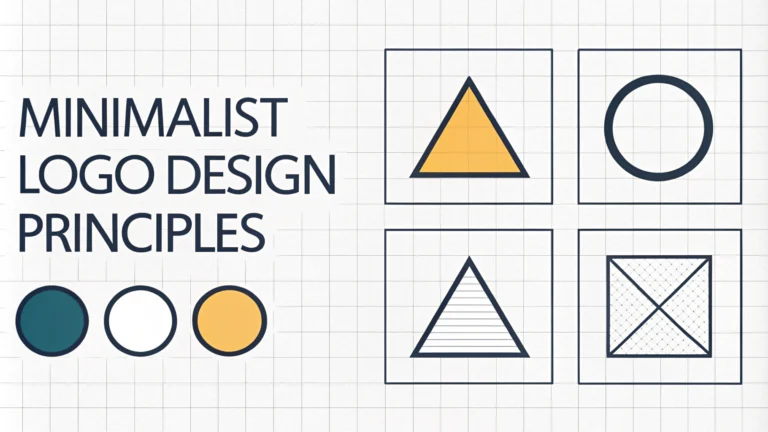Minimalist logo design follows the principle “less is more” to create memorable brand identities.
A clean, simple logo stands out in crowded marketplaces and remains easily recognizable across different sizes and contexts.
Core Principles of Minimalist Logo Design
- Simplify shapes to their basic geometric forms
- Use negative space effectively
- Limit color palette to 1-2 colors
- Choose typography carefully
- Remove unnecessary elements
Typography Tips
Sans-serif fonts like Helvetica, Futura, or Open Sans work best for minimalist logos.
Custom typography can set your brand apart, but keep letter forms clean and readable.
Color Selection
- Black and white creates timeless appeal
- Single bold color shows confidence
- Two-color combinations add visual interest while maintaining simplicity
Space Utilization
Proper spacing between elements helps create visual balance and improves logo recognition.
Negative space can create hidden meanings or secondary images that add depth to simple designs.
Common Mistakes to Avoid
- Adding unnecessary decorative elements
- Using too many colors or gradients
- Overcrowding the design space
- Making the logo too abstract
- Following trendy styles that may date quickly
Testing Your Design
Test your logo design in these contexts:
- Black and white versions
- Various sizes (favicon to billboard)
- Different backgrounds
- Print and digital formats
- Social media profile pictures
Tools for Minimalist Logo Design
- Adobe Illustrator – Professional vector editing
- Figma – Collaborative design tool
- Sketch – Mac-only vector design software
- Canva – User-friendly online tool for beginners
Save your final logo in multiple formats: AI, EPS, SVG, PNG, and JPG for different use cases.
Professional Resources
Connect with professional logo designers through these platforms:
- Behance: www.behance.net
- Dribbble: dribbble.com
- 99designs: 99designs.com
Remember that simplicity requires careful thought and multiple iterations to achieve the perfect balance.
Design Process Steps
Following a structured design process helps achieve effective minimalist logos:
- Research competitor logos and industry trends
- Sketch initial concepts by hand
- Create digital versions of strongest ideas
- Refine chosen direction through iterations
- Get feedback from target audience
Client Communication
Clear communication with clients about minimalist design principles helps set proper expectations.
Present multiple minimal concepts with explanations for design choices and brand relevance.
Future-Proofing Your Logo
- Avoid current design fads
- Focus on timeless geometric shapes
- Create flexible layouts that work across platforms
- Design with scalability in mind
Brand Guidelines
Document clear guidelines for logo usage including:
- Minimum size requirements
- Clear space specifications
- Acceptable color variations
- Prohibited modifications
Conclusion
Minimalist logo design requires careful consideration of every element to create lasting brand identities. Success comes from understanding core principles, avoiding common pitfalls, and maintaining simplicity throughout the design process.
Remember that effective minimalist logos communicate brand values clearly while remaining versatile across all applications. Regular testing and refinement ensure the final design meets both aesthetic and practical requirements.
FAQs
- What defines a minimalist logo design?
A minimalist logo design focuses on simplicity, using only essential elements while eliminating unnecessary details. It typically features clean lines, basic shapes, limited colors, and negative space to create a memorable and versatile design. - How many colors should a minimalist logo have?
A minimalist logo typically uses 1-2 colors maximum. Many successful minimalist logos are monochromatic or use black and white only, though a single accent color can be effective when used purposefully. - What fonts work best for minimalist logos?
Sans-serif fonts like Helvetica, Futura, or Open Sans work best for minimalist logos due to their clean, unembellished appearance. Typography should be simple, legible, and avoid decorative elements. - Is a minimalist logo suitable for all businesses?
While minimalist logos can work for many industries, they’re particularly effective for technology, fashion, modern retail, and professional services. Some businesses may require more elaborate designs to convey their brand personality. - What are the key principles of minimalist logo design?
The key principles include simplicity, clarity, scalability, negative space utilization, balance, and functionality. Each element must serve a purpose, and anything that doesn’t contribute to the core message should be removed. - How do you ensure a minimalist logo remains memorable?
Create visual impact through clever use of negative space, unique shape combinations, or subtle visual tricks. The design should have one distinctive feature that makes it stand out while maintaining simplicity. - What are common mistakes in minimalist logo design?
Common mistakes include oversimplifying to the point of being generic, poor spacing, ignoring scalability, using too many elements, and failing to consider the logo’s application across different mediums. - How important is white space in minimalist logo design?
White space is crucial in minimalist design as it helps create balance, improve readability, and can be used to create clever hidden meanings or shapes. Proper use of white space ensures the logo doesn’t appear cluttered. - What makes a minimalist logo timeless?
A timeless minimalist logo avoids trendy elements, focuses on fundamental design principles, uses classic typography, and maintains relevance across different eras through its simple, refined approach. - How should minimalist logos adapt for different platforms?
Minimalist logos should be designed with responsive variations that maintain their core identity while adapting to different sizes and formats, from favicons to billboards, without losing clarity or impact.







